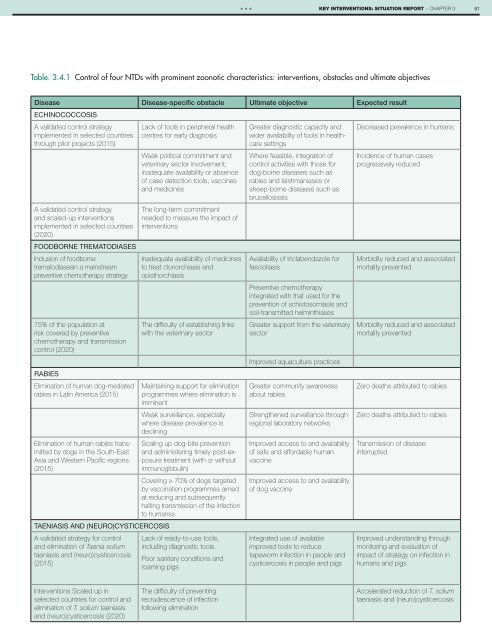1A9bnbK
1A9bnbK
1A9bnbK
You also want an ePaper? Increase the reach of your titles
YUMPU automatically turns print PDFs into web optimized ePapers that Google loves.
***<br />
KEY INTERVENTIONS: SITUATION REPORT − CHAPTER 3<br />
61<br />
Table. 3.4.1 Control of four NTDs with prominent zoonotic characteristics: interventions, obstacles and ultimate objectives<br />
Disease Disease-specific obstacle Ultimate objective Expected result<br />
ECHINOCOCCOSIS<br />
A validated control strategy<br />
implemented in selected countries<br />
through pilot projects (2015)<br />
A validated control strategy<br />
and scaled-up interventions<br />
implemented in selected countries<br />
(2020)<br />
FOODBORNE TREMATODIASES<br />
Inclusion of foodborne<br />
trematodiasesin a mainstream<br />
preventive chemotherapy strategy<br />
75% of the population at<br />
risk covered by preventive<br />
chemotherapy and transmission<br />
control (2020)<br />
RABIES<br />
Elimination of human dog-mediated<br />
rabies in Latin America (2015)<br />
Elimination of human rabies transmitted<br />
by dogs in the South-East<br />
Asia and Western Pacifi c regions<br />
(2015)<br />
TAENIASIS AND (NEURO)CYSTICERCOSIS<br />
A validated strategy for control<br />
and elimination of Taenia solium<br />
taeniasis and (neuro)cysticercosis<br />
(2015)<br />
Lack of tools in peripheral health<br />
centres for early diagnosis<br />
Weak political commitment and<br />
veterinary sector involvement;<br />
inadequate availability or absence<br />
of case detection tools, vaccines<br />
and medicines<br />
The long-term commitment<br />
needed to measure the impact of<br />
interventions<br />
Inadequate availability of medicines<br />
to treat clonorchiasis and<br />
opisthorchiasis<br />
The diffi culty of establishing links<br />
with the veterinary sector<br />
Maintaining support for elimination<br />
programmes where elimination is<br />
imminent<br />
Weak surveillance, especially<br />
where disease prevalence is<br />
declining<br />
Scaling up dog-bite prevention<br />
and administering timely post-exposure<br />
treatment (with or without<br />
immunoglobulin)<br />
Covering > 70% of dogs targeted<br />
by vaccination programmes aimed<br />
at reducing and subsequently<br />
halting transmission of the infection<br />
to humanss<br />
Lack of ready-to-use tools,<br />
including diagnostic tools.<br />
Poor sanitary conditions and<br />
roaming pigs<br />
Greater diagnostic capacity and<br />
wider availability of tools in healthcare<br />
settings<br />
Where feasible, integration of<br />
control activities with those for<br />
dog-borne diseases such as<br />
rabies and leishmaniases or<br />
sheep-borne diseases such as<br />
brucellosissis<br />
Availability of triclabendazole for<br />
fascioliasis<br />
Preventive chemotherapy<br />
integrated with that used for the<br />
prevention of schistosomiasis and<br />
soil-transmitted helminthiases<br />
Greater support from the veterinary<br />
sector<br />
Improved aquaculture practices<br />
Greater community awareness<br />
about rabies<br />
Strengthened surveillance through<br />
regional laboratory networks<br />
Improved access to and availability<br />
of safe and affordable human<br />
vaccine<br />
Improved access to and availability<br />
of dog vaccine<br />
Integrated use of available<br />
improved tools to reduce<br />
tapeworm infection in people and<br />
cysticercosis in people and pigs<br />
Decreased prevalence in humans<br />
Incidence of human cases<br />
progressively reduced<br />
Morbidity reduced and associated<br />
mortality prevented<br />
Morbidity reduced and associated<br />
mortality prevented<br />
Zero deaths attributed to rabies<br />
Zero deaths attributed to rabies<br />
Transmission of disease<br />
interrupted<br />
Improved understanding through<br />
monitoring and evaluation of<br />
impact of strategy on infection in<br />
humans and pigs<br />
Interventions Scaled up in<br />
selected countries for control and<br />
elimination of T. solium taeniasis<br />
and (neuro)cysticercosis (2020)<br />
The diffi culty of preventing<br />
recrudescence of infection<br />
following elimination<br />
Accelerated reduction of T. solium<br />
taeniasis and (neuro)cysticercosis


